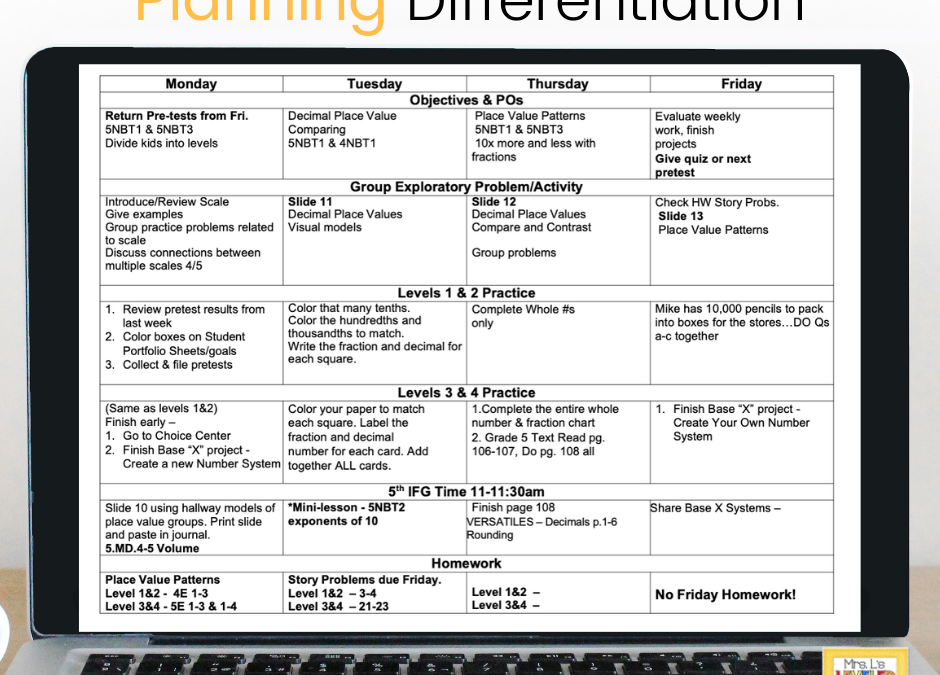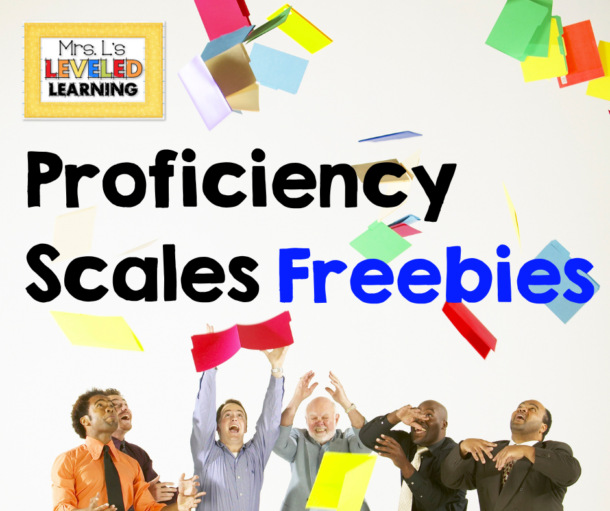By Melanie LiCausi of Mrs. L’s Leveled Learning
What are your beliefs about differentiation?
When you look at the diversity in your classroom, does it seem possible to reach every student? Maybe you haven’t tried to differentiate your lessons for some of these reasons…
“I would have to plan several activities for every lesson instead of one or two.”
“I would have to have different assignments for everyone.”
“It’s too difficult to keep track of multiple activities and how would I grade them if they’re doing different things?”
“Differentiation sounds like the right thing to do, but I just don’t have time to plan anything else.”
There have been many approaches to differentiation for learning and thinking modalities, multiple intelligences, choice menus, genius hours, intervention and extension approaches. All of these approaches involve planning different lessons or activities for different groups. I like to call this horizontal differentiation. You have students doing different activities at a similar level of cognitive difficulty. YES, this is time consuming!
What if differentiation was just based on a naturally logical path of learning?
Start with background knowledge and end with opportunities for in-depth application. I like to call this vertical differentiation. This means that students are working on the same topic or standard, at different levels of cognitive difficulty. If you are familiar with Blooms or Marzano Taxonomy of Higher Order Thinking skills, then you already have an idea of vertical differentiation. The examples below will show you how the vertical levels of cognitive difficulty (from easiest to hardest) in a proficiency scale, can simplify your differentiation planning and instruction.
What are Proficiency Scales?
Proficiency Scales were popularized in Robert Marzano’s book, The Art and Science of Teaching: A Comprehensive Framework for Effective Instruction. His research cited that using “Learning Goals” with a “Scale” (i.e. proficiency scales), was one of the most effective strategies for increasing student performance. The structure of a scale consists of some kind of learning standard or objective, then breaking the standard down into related but simpler steps toward mastery. You probably already do this when you see a student struggling with content. You instantly think of how to draw a picture, create a simpler model, or review something from a previous lesson that they might connect to. The idea of a written scale is that you anticipate these modifications ahead of time. They are designed with a logical progression of learning for that content standard, which means it can be predictable. You are just writing it down in a sequence. This pre-planning allows you the flexibility to think on your toes as well as prepare effective modifications for the students.
Your higher-achieving students can also benefit from a scale. After breaking down your grade level goal into easier steps, you can plan an opportunity for enrichment or extension of the same standard. You’ll see this in Level 4 of my scale below. This proficiency scale becomes a quick outline of differentiation that informs your planning, instruction, and assessment goals. Small but related adjustments to your activity or instruction become easier. We’ve all had those students who sit in class keeping themselves busy with anything except the lesson. Scales offer you a way to engage all of them in your standard at some level. Understanding how to level your content from easy to challenging, is the next step. There are two methods I use to scaffold the steps in a scale. First by aligning the content of related standards from adjacent grade levels. Secondly, by aligning the sequence of steps in terms of their cognitive difficulty (DOK). The following example combines both approaches.
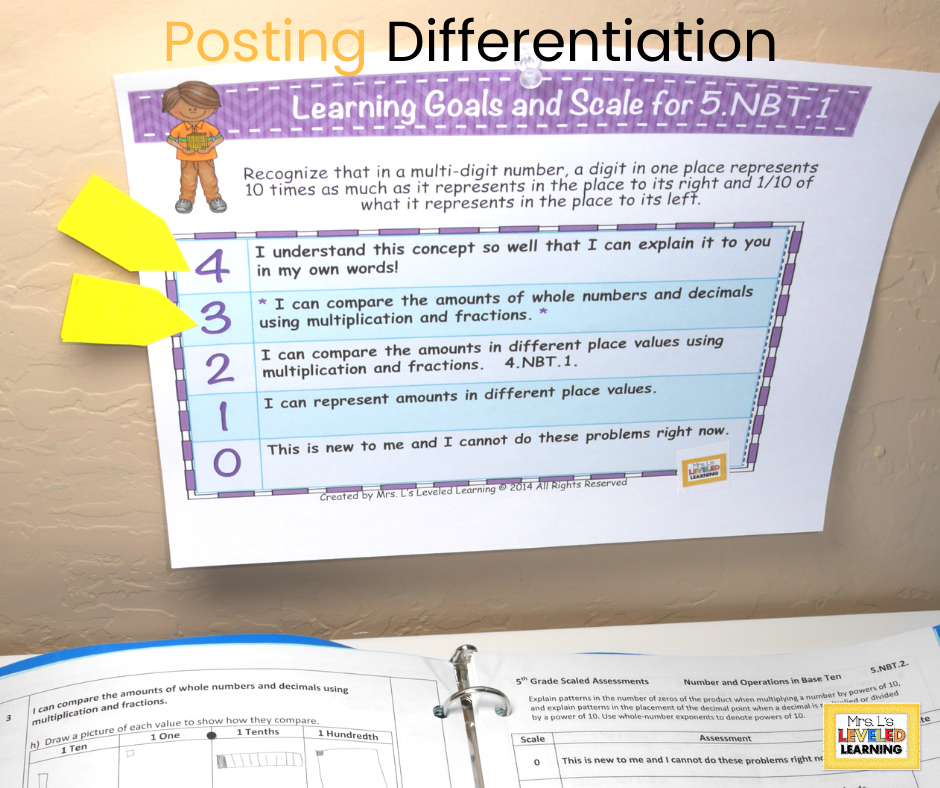
My Background With Proficiency Scales
I had been working in a Title I public school teaching Gifted Resource .75 and Reading Intervention .25. My first job in a public school, and I didn’t even know a position could be divided this way. This opportunity to work with the lowest and highest performing students in our building, positioned me to see the needs of both ends of the spectrum. I had been applying different teaching strategies for both groups of students, and began to recognize what worked and what didn’t.
After two years of this split position, I was assigned to teach only Gifted Resource in two different Title I schools. My role was to teach Math and ELA for 90- minute periods, four days a week. My multi-age group consisted of 4th and 5th graders. Our Title I schools had very low numbers of qualified “gifted” students, meaning they had to score in the 97th percentile or higher on the Cognitive Abilities Test. To fill the gap, my class was open to high-achieving students who showed a lot of academic potential. When planning my lessons for these classes I essentially had three leveled groups of students working on different things… My 4th graders who were high achieving, my 4th graders who were “gifted” combine with my 5th graders who were high achieving, and then my fifth graders who were qualified as gifted. I gave myself grace the first year to figure out how to align both 4th, 5th and sometimes middle school standards to the needs of three different groups. By necessity, I developed a simplified method for differentiation. My approach was to pair 4th and 5th grade standards that had a common instructional idea, breakdown the core elements, and level them from easiest to hardest. Sounds familiar, right? (Proficiency Scales!!) The following images demonstrate the way I differentiated instruction for Math. Simple modifications, like the levels in a scale, made this manageable for me. Many schools are now using this approach under the name, Standards Based Grading.
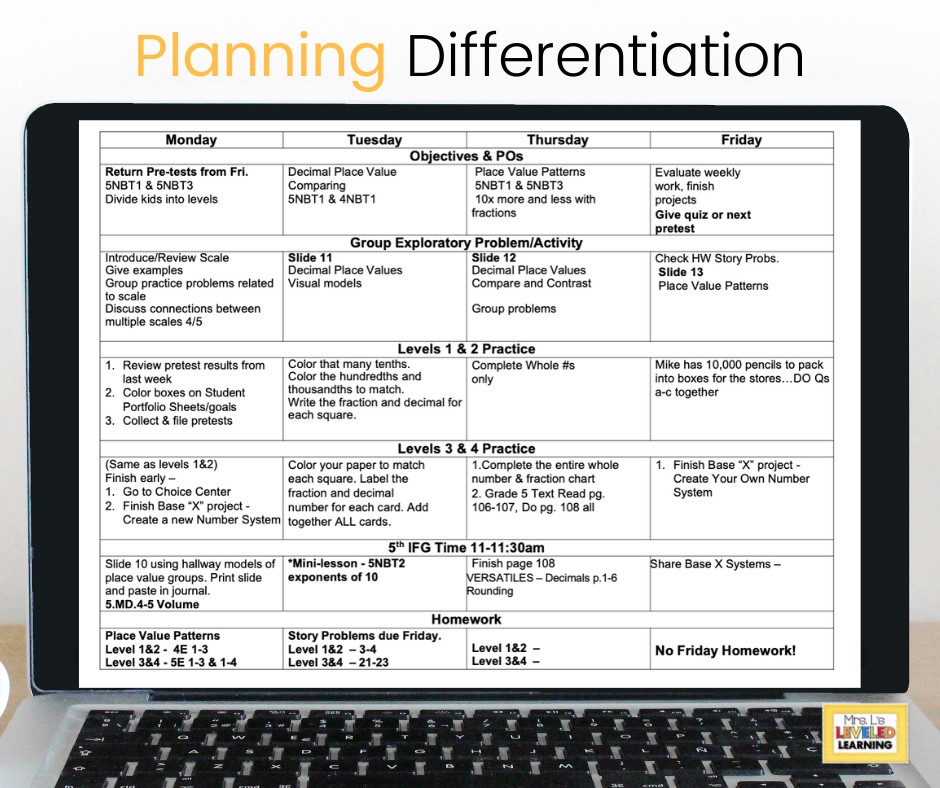
My lesson planning template provided space for objectives, introductions, leveled practice, homework, and small group activities. “IFG” was our “Individual Focus Group” time for small group intervention or enrichment.
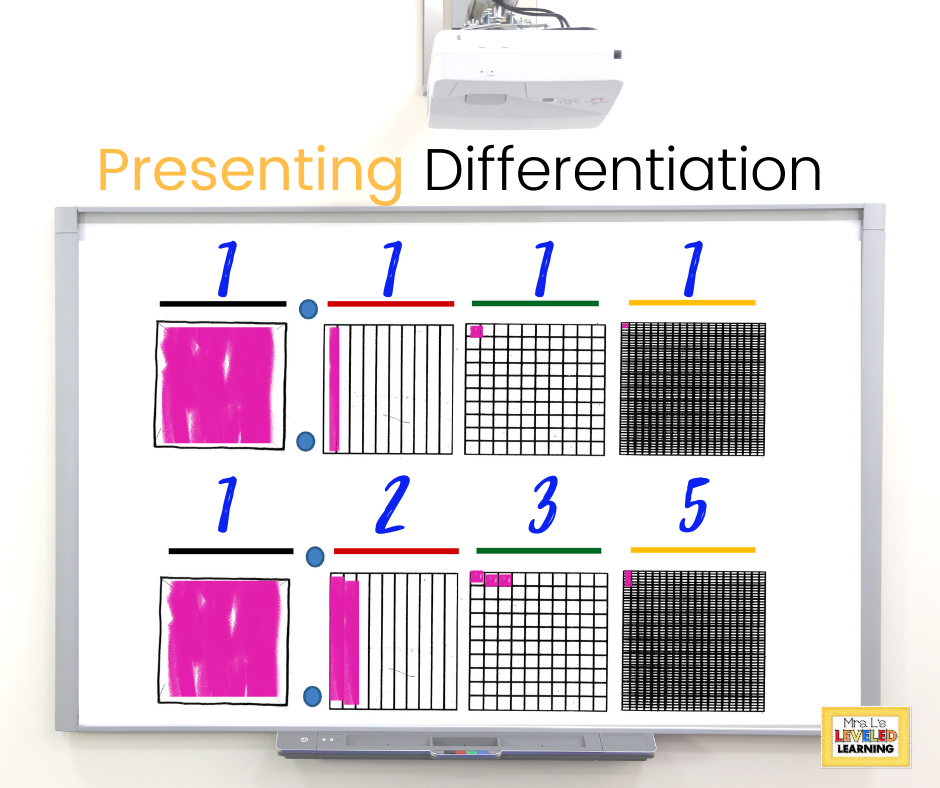
Tuesday: This lesson slide helped me introduce the two different tasks for my groups. (I combined levels 1&2, 3&4).
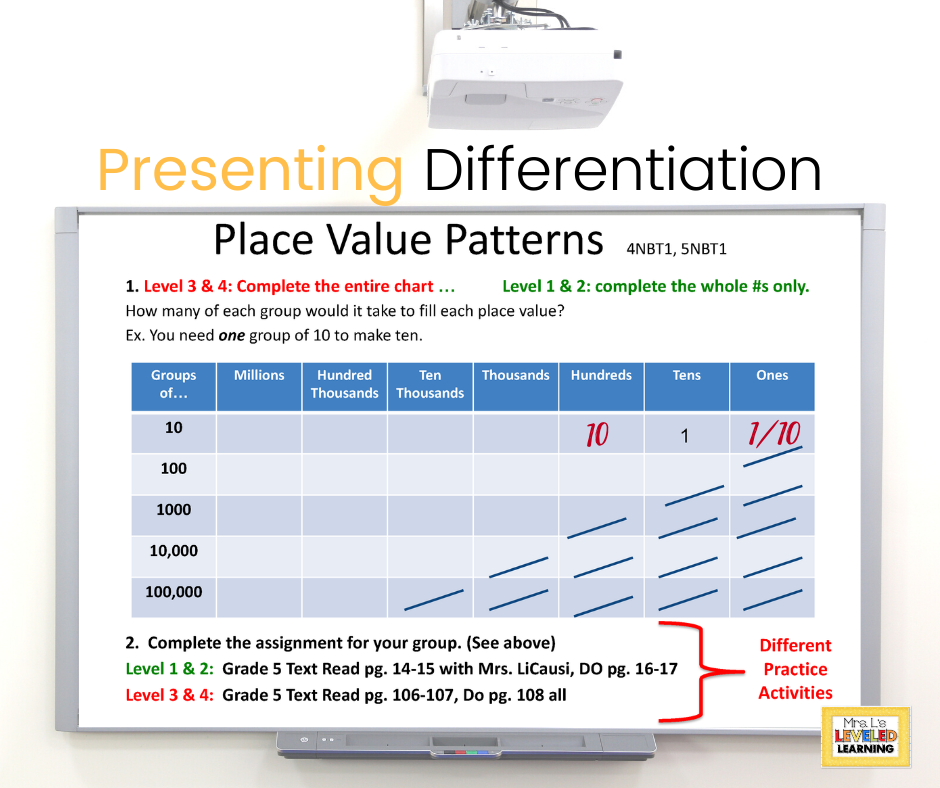
Thursday: My two practice groups are asked to recognize the patterns in the Base 10 Place Value system. Notice the task for Levels 3&4 is just an extension of the Level 1&2 task. This means that if my high group struggles, they will be doing the easier task first to help them SEE the pattern. If students from my lower group get it quickly, they can instantly level up to the more difficult task. It’s already planned so no extra stress during class time!
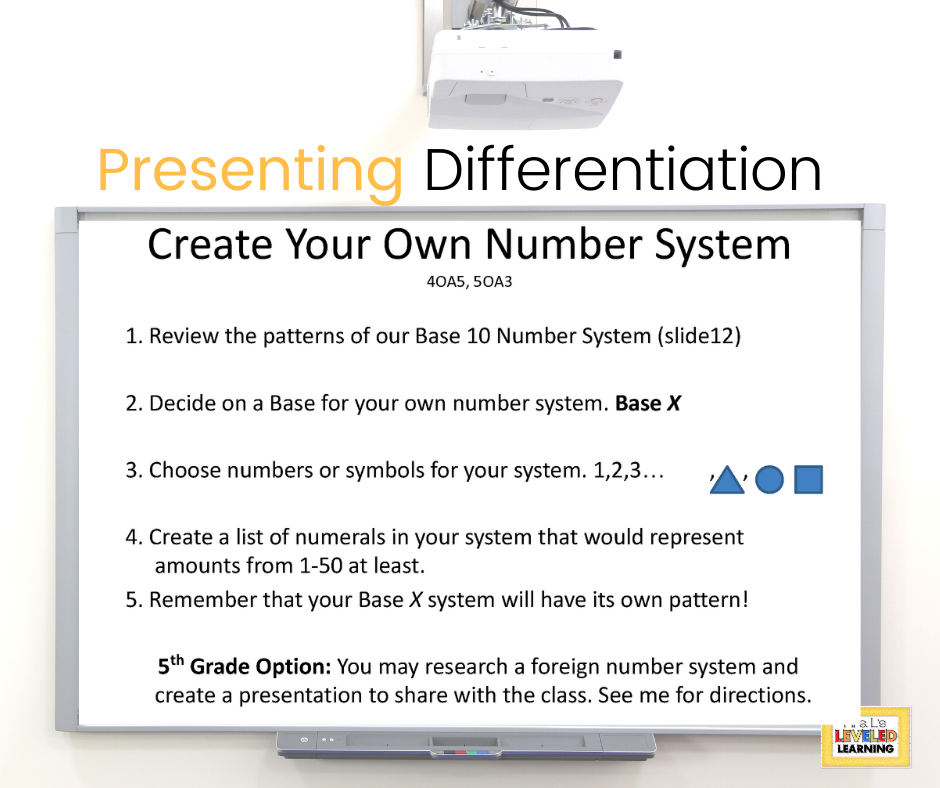
Monday & Friday: The Base “X” Project is explained and assigned to my fast-finishers to work on throughout the week. Notice that it is directly connected to finding and creating patterns in number systems. Fun! If you have more low students than high, you might plan one extra review activity for the week. I found that low students need lots of repetition and visual modeling!
My District Adopted Marzano Proficiency Scales
We had two professional development meetings and then we were on our own. I decided to go back to the essential standards that I had been using to plan for my multiage classes. I started to research the Common Core committee’s Progression of Standards document. It explains how different grade-level standards align in the clusters of mathematics. This may sound backwards, but I started creating assessment tasks along with my learning goals before I created individual scales. I really struggled with the ambiguity of scales. I wanted to see how my students would work with the structure. Creating small assessments gave me immediate feedback. I could see if the logic in my sequence was effective or faulty. After a year and a half, I had three grades of Leveled Assessments and Scales. My students were able to witness their own progress like never before. We were all excited! Since then, I have completed scales and assessments for Math and ELA, grades 1 through 8. You could say I’ve had plenty of practice!
We all want to reach every student!
I don’t believe any teacher goes into this profession expecting to leave students behind; but if our approach stretches us so thin that we cannot practically accomplish it, then what is the benefit? How we teach largely depends on who we teach. Until Proficiency Scales, I haven’t come across a simpler way to differentiate with so much potential impact! The fact is, no matter who you are teaching; no matter what their processing modality, learning style, language, culture, cognitive capacity, socio-economic status, personal circumstances, or developmental needs, every student in your grade is expected to master the same curriculum standard in the same amount of time. Is it just me, or does this sound like a recipe for frustration? How often do we give ourselves credit for the enormity of the job that we take on? We deserve a way to make this process manageable. In the end, this will help us to deliver more consistent modifications to every child we teach.
Thank you to Jennifer C. who commented on
4th Grade Math Assessment with Marzano Proficiency Scales
“I am able to use this to assess the level each student is on each standard. Super helpful! It saves so much time. Thank you!” – September 24, 2021

